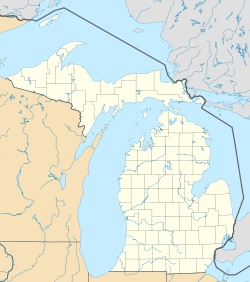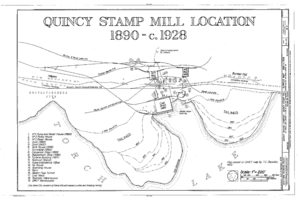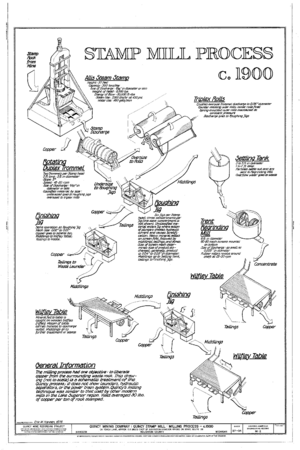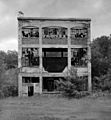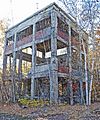Quincy Mining Company Stamp Mills Historic District facts for kids
Quick facts for kids |
|
|
Quincy Mining Company Stamp Mills Historic District
|
|
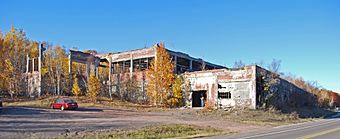
Addition to Stamp Mill Number One in 2010
|
|
| Location | M-26 near Torch Lake, Osceola Township |
|---|---|
| Area | 350 acres (140 ha) |
| Built | 1888 |
| Architectural style | Colonial Revival |
| NRHP reference No. | 07000750 |
| Added to NRHP | July 18, 2007 |
The Quincy Mining Company Stamp Mills Historic District is a special historical site in Michigan. It was once home to large machines called stamp mills. These mills were used to crush rocks that contained copper, helping to separate the valuable copper from other materials. You can find this historic district on M-26 near Torch Lake, close to the town of Mason. It became a recognized historic place on the National Register of Historic Places in 2007.
Contents
Early Days: The First Stamp Mill (1860–1888)
The first Quincy Stamp Mill was built in 1860. It was located in Hancock, right next to the Quincy Mine. This mill, however, caused a big problem. It dumped huge amounts of sand and waste into Portage Lake.
This sand started to fill up the lake's shipping channels. By the mid-1880s, the government set strict rules about dumping. They even sued the Quincy Mine for polluting Portage Lake. At the same time, Quincy Mine was growing. They were buying the nearby Pewabic Mine and knew they would need a much bigger mill.
Stamp mills need a lot of water to work. This meant a new mill had to be built near a large body of water. After looking at different places, the Quincy company chose Torch Lake. They bought 300 acres of land there, about six miles east of their old location.
Building the New Mill (1888–1894)
Construction on the new stamp mill began in 1888. The first building they put up was a place for workers to live. Then came a dock, a water tank, and foundations for other buildings. In 1889, six large wooden buildings were built. A railway was also added to connect the mill to the mine.
The first main mill building was made of wood and was very large. The pump and boiler house, which provided power, was a stone building. A raised path carried water and steam over the road to the mill. The whole facility was finished and started working in 1890. It began with two crushing machines, called stamps. A third was added soon after, and two more were put in by 1892.
More buildings were added over time. The dock was made longer in 1890 and 1891. The boiler house and the main mill also got additions. Between 1888 and 1894, the Quincy Mine spent a lot of money, about $457,000, to build and equip this new mill site.
Expanding the Mills (1894–1922)
Even with the new mill, the mine was producing more copper ore than the mill could handle by 1894. So, plans for a second mill began.
The second stamp mill was built just north of the first one. This mill was made with an iron frame and was also very large. It was built in 1899 and cost about $22,450. The second mill opened in late 1900 with three more crushing machines. New boiler and pump houses were also built to support this extra capacity. Over the next 20 years, small changes were made to the buildings. The machines and the milling process were always being improved. For example, a new 175-foot smokestack was built for the boilerhouse in 1916.
The price of copper went up a lot during World War I. This gave the company money and a reason to expand the site even more. Large additions made of concrete and brick were built onto both stamp mills in 1919. These additions were ready and working by 1920. The mill also improved how it made electricity. A new building was constructed to hold a powerful turbine near the first mill. This brick building was started in 1921, and the turbine was running by 1923.
The Mills' Later Years (1922 – present)
After World War I ended, the mill started to slow down. In 1922, the second mill was closed. New, more efficient equipment was added to the first mill in 1929 and 1930. However, the Great Depression hit the mining industry very hard. The Quincy Mine closed in 1931, which meant the Stamp Mills also shut down.
As the Depression continued, copper prices eventually went back up. The mine and mills were fixed up in late 1937 and reopened on a small scale in early 1938. But the mine barely made any money. After World War II ended, the government stopped guaranteeing copper prices. Because of this, the mine and stamp mills closed for good.
Mill number two was taken down early. Parts of the original mill number one were also removed. However, the later additions to mill number one still stand today.
Images for kids


